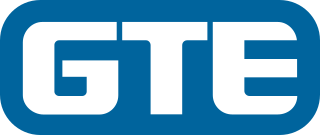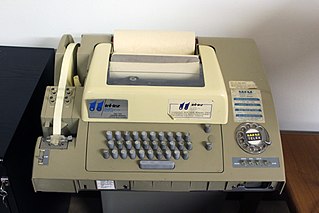Related Research Articles

GTE Corporation, formerly General Telephone & Electronics Corporation (1955–1982), was the largest independent telephone company in the United States during the days of the Bell System. The company operated from 1926, with roots tracing further back than that, until 2000, when it was acquired by Bell Atlantic; the combined company took the name Verizon.

A Regional Bell Operating Company (RBOC) was a corporate entity created as result of the antitrust lawsuit by the U.S. Department of Justice against the American Telephone and Telegraph Company (AT&T) in 1974 and settled in the Modification of Final Judgment on January 8, 1982.

Bell Canada is a Canadian telecommunications company headquartered at 1 Carrefour Alexander-Graham-Bell in the borough of Verdun, Quebec, in Canada. It is an ILEC in the provinces of Ontario and Quebec; as such, it was a founding member of the Stentor Alliance. It is also a CLEC for enterprise customers in the western provinces.
The Pacific Bell Telephone Company (Pac Bell) is a telephone company that provides telephone service in California. The company is owned by AT&T through AT&T Teleholdings, and, though separate, is now marketed as “AT&T”. The company has been known by a number of names during which its service area has changed. The formal name of the company from the 1910s through the 1984 Bell System divestiture was The Pacific Telephone and Telegraph Company. As of 2002, the name “Pacific Bell” is no longer used in marketing, although Pacific Bell is still the holder of record for the infrastructure of cables and fiber through much of California.
US West, Inc., doing business as U S West, was one of seven Regional Bell Operating Companies, created in 1983 under the Modification of Final Judgement, a case related to the antitrust breakup of AT&T. US West provided local telephone and intraLATA long-distance services, data transmission services, cable television services, wireless communications services and related telecommunications products to defined areas in Arizona, Colorado, Idaho, Iowa, Minnesota, Montana, Nebraska, New Mexico, North Dakota, Oregon, South Dakota, Utah, Washington, and Wyoming. US West was a public company traded on the New York Stock Exchange under the ticker symbol "USW" with headquarters at 1801 California Street in Denver, Colorado.

Cincinnati Bell, Inc., doing business as Altafiber, is a regional telecommunications service provider based in Cincinnati, Ohio, United States. It provides landline telephone, fiber-optic Internet, and IPTV services through its subsidiaries Altafiber Home Phone and Hawaiian Telcom, which are the incumbent local exchange carriers for the Greater Cincinnati metropolitan area and Hawaii. Other subsidiaries provide enterprise information technology services and long distance calling.

A business telephone system is a telephone system typically used in business environments, encompassing the range of technology from the key telephone system (KTS) to the private branch exchange (PBX).

The monopoly position of the Bell System in the U.S. was ended on January 8, 1982, by a consent decree providing that AT&T Corporation would, as had been initially proposed by AT&T, relinquish control of the Bell Operating Companies, which had provided local telephone service in the United States. AT&T would continue to be a provider of long-distance service, while the now-independent Regional Bell Operating Companies (RBOCs), nicknamed the "Baby Bells", would provide local service, and would no longer be directly supplied with equipment from AT&T subsidiary Western Electric.
Verizon New York, Inc., formerly The New York Telephone Company (NYTel), was organized in 1896, taking over the New York City operations of the American Bell Telephone Company.

Northwest Fiber, LLC, doing business as Ziply Fiber, is an American telecommunications company based in Kirkland, Washington. Ziply is a subsidiary of WaveDivision Capital, a private investment company, which is also Kirkland-based. The company started operations on May 1, 2020, when it completed its acquisition of Frontier Communications Northwest operations and assets for $1.4 billion; Frontier sold its Northwest operations after filing for bankruptcy protection in April 2020. Ziply Fiber's footprint covers the Pacific Northwest region, specifically the states of Washington, Oregon, Idaho and Montana. Its key offerings include fiber internet and phone for residential customers, Business Fiber Internet, and Ziply Voice services for small businesses; and a variety of internet, networking and voice solutions for enterprise customers. The company will also continue to support DSL and grandfathered TV customers. Ziply has stated that it plans on investing $500 million to improve its network and service throughout its footprint. This includes the goal of bringing fiber to nearly 85% of its network, which mainly encompasses rural communities. As of June 2020, approximately 30% have access to fiber.
Frontier California, Inc. is a Frontier Communications-owned operating company providing telephone service in former Verizon regions. This included Southern California cities such as Long Beach, Seal Beach, Lakewood, Norwalk and Santa Monica.
Qwest Corporation is a Regional Bell Operating Company owned by Lumen Technologies. It was formerly named U S WEST Communications, Inc. from 1991 to 2000. It was also named Mountain States Telephone and Telegraph Company–later Mountain Bell from 1911 to 1991. In the early 2010s the Mountain Bell name was resurrected by CenturyLink, Inc. In other words, Mountain Bell Telephone Company still exists but the MB corporate name is no longer used from 1991 and afterwards. Mountain Bell now does business as the Lumen Technologies. It includes the former operations of Malheur Bell, Northwestern Bell and Pacific Northwest Bell as well. The NWBT and PNB companies still exist but no longer use the names for marketing or as corporate identities.

Frontier Communications Parent, Inc. is an American telecommunications company. Known as Citizens Utilities Company until 2000, Citizens Communications Company until 2008, and Frontier Communications Corporation until 2020, as a communications provider with a fiber-optic network and cloud-based services, Frontier offers broadband internet, digital television, and computer technical support to residential and business customers in 25 states. In some areas it also offers home phone services.

The Kellogg Switchboard and Supply Company was an American manufacturer of telecommunication equipment. Anticipating the expiration of the earliest, fundamental Bell System patents, Milo G. Kellogg, an electrical engineer, founded the company in 1897 in Chicago to produce telephone exchange equipment and telephone apparatus.

A telephone number is a sequence of digits assigned to a landline telephone subscriber station connected to a telephone line or to a wireless electronic telephony device, such as a radio telephone or a mobile telephone, or to other devices for data transmission via the public switched telephone network (PSTN), or other public and private networks. Modern smart phones have added a built-in layer of abstraction whereby individuals or businesses are saved into a contacts application and the numbers no longer have to be written down or memorized.

Qwest Communications International, Inc. was a United States telecommunications carrier. Qwest provided local service in 14 western and midwestern U.S. states: Arizona, Colorado, Idaho, Iowa, Minnesota, Montana, Nebraska, New Mexico, North Dakota, Oregon, South Dakota, Texas, Utah, Washington, and Wyoming.

The Bell System was a system of telecommunication companies, led by the Bell Telephone Company and later by the American Telephone and Telegraph Company (AT&T), that dominated the telephone services industry in North America for over 100 years from its creation in 1877 until its antitrust breakup in 1983. The system of companies was often colloquially called Ma Bell, as it held a vertical monopoly over telecommunication products and services in most areas of the United States and Canada. At the time of the breakup of the Bell System in the early 1980s, it had assets of $150 billion and employed over one million people.

Telex is a telecommunication service that provides text-based message exchange over the circuits of the public switched telephone network or by private lines. The technology operates on switched station-to-station basis with teleprinter devices at the receiving and sending locations. Telex was a major method of sending text messages electronically between businesses in the post–World War II period. Its usage went into decline as the fax machine grew in popularity in the 1980s.
Pacific Telecom, Inc., originally Telephone Utilities, Inc. and now CenturyTel of the Northwest, Inc., was an independent telephone company that owned over 600,000 telephone lines in 12 states prior to its acquisition by CenturyTel.

AT&T Communications, Inc., doing business as AT&T Communications, was a division of the AT&T Corporation that, through 23 subsidiaries, provided interexchange carrier and long-distance telephone services.
References
- ↑ Frontier Corp. -- Company History, Funding Universe
- ↑ Frontier Corp., Rochester, NY, Company Profile
- ↑ The Journal Record article [ permanent dead link ]
- ↑ Journal Record article at Findarticles.com
- ↑ Bittner quits CEO post, citing health concerns, Rochester Business Journal
- ↑ Ronald Bittner, 55, Telephone Executive, New York Times
- ↑ Citizens Communications Co - 10-K - For 12/31/02
- ↑ Frontier Communications Corp - Form 10-K - Ex. 21-1 - List of Subsidiaries - February 26, 2010
- ↑ FCC Carrier Filing History for RTC
